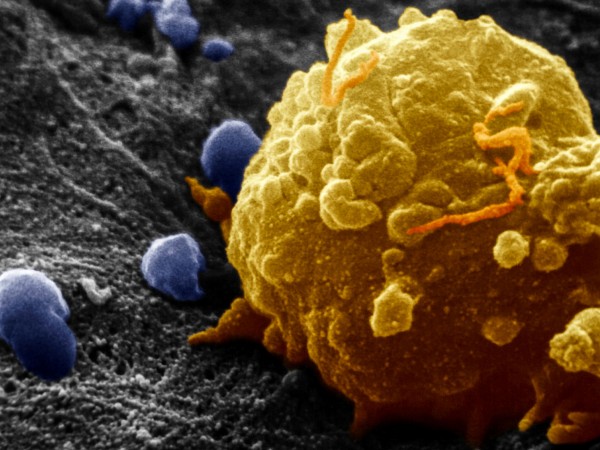When a person dies from cancer, the culprit is usually not the original tumor but rather the cancerous cells that spread throughout the body and replicate in distant organs, a process called metastasis. Researchers have long known that metastasizing cancer cells slip their bonds and avoid immune detection by altering the sugars on their surfaces. They’ve even come up with a would-be drug to prevent such sugar alterations. But that compound interferes with needed sugars on normal cells, too, with lethal results in animals. Now, Dutch researchers report that they’ve packaged the drug in nanoparticles targeted exclusively to cancer cells, and they’ve shown that this combination prevents cancer cells from metastasizing in mice.
The new nanotech therapy still has a long way to go before becoming a medicine, including passing safety and effectiveness trials in humans. Nevertheless, “it’s promising,” says Cory Rillahan, a chemical biologist at Memorial Sloan Kettering Cancer Center in New York City who wasn’t connected to the study. Rillahan, who 3 years ago was part of the team to first report the antimetastatic drug compound, known as P-3Fax-Neu5Ac, says the compound was designed to block a family of 20 enzymes that alter sugars known as sialic acids. Sialic acids often cap long chains of other sugar molecules that are attached to proteins and lipids that stud cell surfaces. Those chains have been shown to be involved in cell adhesion and recognition, key processes co-opted by metastatic cancer cells.
Several types of cancer cells overexpress enzymes that add sialic acids to sugar chains. But shutting these enzymes all off can be dangerous. Last year, a team led by James Paulson, a chemist at the Scripps Research Institute in San Diego, California, who leads the lab where Rillahan did his work on P-3Fax-Neu5Ac, found that the drug caused fatal kidney damage in mice when injected into the bloodstream. So for P-3Fax-Neu5Ac to have a shot as an antimetastasis drug, it must target cancer cells.
That’s the step that researchers led by Gosse Adema, a tumor immunologist at the Radboud University Medical Center in Nijmegen, the Netherlands, have now taken. In a paper posted online this month in ACS Nano, Adema and his colleagues report packaging P-3Fax-Neu5Ac into nanosized, biodegradable vesicles made from poly(lactic-co-glycolic acid), or PLGA, a compound already approved for use by the U.S. Food and Drug Administration. They then coated the vesicles with antibodies that home in on a protein overexpressed on the surface of melanoma cells. Melanoma cells commonly metastasize to the lungs. So in their study, Adema and his colleagues checked whether melanoma cells spread to the lung in mice.
It is difficult for lab researchers to quickly study metastases from solid tumors, because they might have to wait for months for rogue cells to slip away. So to speed things up, Adema’s team relied on a standard procedure of injecting cancer cells and the antimetastatic drug into the tail veins of mice and waiting for 2 weeks to see whether the cells began to form new tumor nodules. After 14 days, the Dutch team found that mice that had received the drug-loaded nanovesicles developed 75% fewer tumor nodules in their lungs than did mice given empty nanovesicles.
Whether this therapy will succeed in humans remains uncertain, because most drugs that work in mice don’t do so in people. The synthesis of sugar chains on cells, known as glycosylation, differs between humans and mice, so any prospective drug would need to prevent glycosylation in human cancer cells as well. Still, Paulson says, the new finding “opens the door” to the prospect of drugs that inhibit glycosylation as an alternative, or additional, strategy to combat metastatic cancer. Such a discovery won’t make an overnight cancer cure. But it could help researchers learn to prevent the spread of cancer, the disease’s most lethal weapon.

